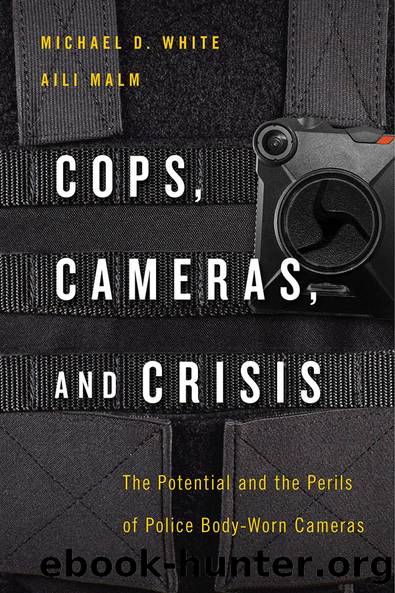Cops, Cameras, and Crisis by Michael D. White Aili Malm

Author:Michael D. White, Aili Malm [Michael D. White, Aili Malm]
Language: eng
Format: epub
Tags: Social Science, Criminology
ISBN: 9781479831579
Google: TkWODwAAQBAJ
Publisher: NYU Press
Published: 2020-02-25T03:21:56+00:00
SOCIETAL CULTURE
Societal culture often can play an influential role in diffusion of an innovation. Laws, values, and norms can either facilitate or hinder the adoption patterns of an innovation. There are two aspects of culture that are especially relevant for examination of technology in policing. The first is the court system. The courts play a critical role through examination of cases that establish the parameters of BWC policy and practice. For example, the Boston police union filed an injunction in federal court to stop the leadershipâs planned rollout of BWCs.72 The courts have also ruled on a range of controversial issues, such as the public release of footage,73 the implications of failure to record an encounter or the deletion of video prior to a court case,74 and whether BWC deployments must be negotiated as part of collective bargaining between the department and the officersâ union.75 The courts are also âconsumersâ of BWC footage, as the evidentiary value of cameras has implications for the processing and adjudication of criminal cases. The successful integration of BWC footage into court-case processing (by prosecutors and defense) will certainly influence the technologyâs rate of diffusion.
The second aspect of culture relevant for BWCs involves citizensâ beliefs about the technology. What do citizens think about police BWCs? A number of studies have shown that citizensâ support for BWCs is high, both among the general population and among citizens who have BWC-recorded encounters with police.76 For example, White and colleagues conducted interviews with 279 citizens who had recent encounters with Tempe (Arizona) police officers and found high levels of acceptance: more than 90 percent of citizens agreed or strongly agreed that BWCs should be worn by all Tempe officers; nearly 80 percent agreed or strongly agreed that BWCs would make officers behave more professionally and citizens act more respectfully; and 84 percent agreed or strongly agreed that the benefits of BWCs outweigh the costs.77 Similarly positive results have been reported among citizens who were recorded by police in Spokane (Washington),78 Anaheim (California),79 and Arlington (Texas).80 Citizensâ support for BWCs is likely to fuel the continued diffusion of the technology in policing. The diffusion of innovations framework helps us answer three of the questions posed at the beginning of this chapter, but to understand whether BWCs have been successful and how this real or perceived success will impact the future of the technology in policing, we turn to evidence-based policing.
Download
This site does not store any files on its server. We only index and link to content provided by other sites. Please contact the content providers to delete copyright contents if any and email us, we'll remove relevant links or contents immediately.
Russia's Sakhalin Penal Colony, 1849â1917 by Andrew A. Gentes(176)
A History of Police and Masculinities, 1700-2010 by David G. Barrie Susan Broomhall(128)
Introduction to Criminal Justice - A Balanced Approach by Brian K. Payne Willard M. Oliver Nancy E. Marion(124)
Serial Killers America and UK - 2 BOOKS IN 1 by Clark Matthew(108)
Policing Gender, Class And Family In Britain, 1800-1945 by Linda Mahood(96)
Cops, Cameras, and Crisis by Michael D. White Aili Malm(90)
Restorative Justice in Transitional Settings by Kerry Clamp(88)
Dangerousness, Risk and the Governance of Serious Sexual and Violent Offenders by Karen Harrison(88)
Organized Crime and Corruption Across Borders by T. Wing Lo Dina Siegel Sharon I Kwok(85)
A Theory of African American Offending by James D. Unnever Shaun L. Gabbidon(82)
Losing Legitimacy by Gary Lafree(78)
The Real CSI by Kate Bendelow(76)
Women Exiting Prison by Bree Carlton Marie Segrave(73)
Routledge Handbook on Immigration and Crime by Holly Ventura Miller Anthony Peguero(73)
Forensic Criminology by Andy Williams(73)
The 1921 Tulsa Race Massacre by Chris M. Messer(73)
Broadmoor--My Journey Into Hell by Charlie Bronson(72)
Police Detectives in History, 1750â1950 by Clive Emsley Haia Shpayer-Makov(72)
Using Murder by Philip Jenkins(67)
